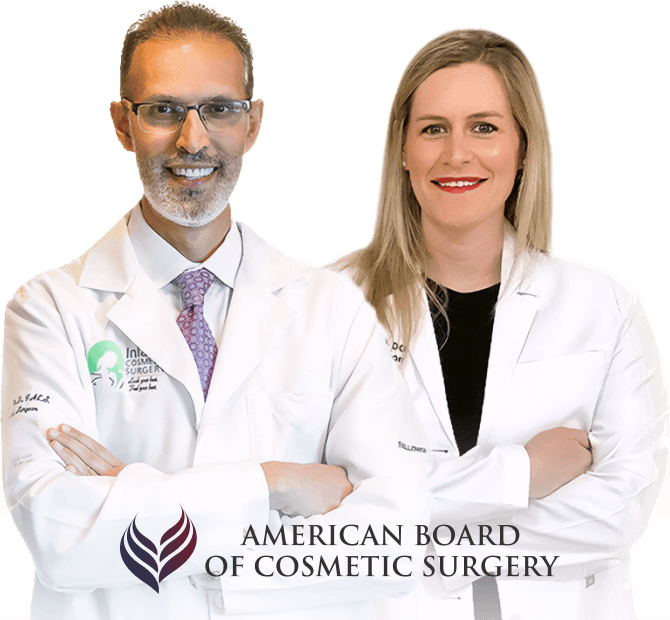Pectoral Augmentation (Pec Implants)
Even after years of dedicated training, the pectoral muscles may lack the definition you’ve worked hard to sculpt. Pec implants are specifically designed to give your chest a muscular appearance that looks completely natural. Our Rancho Cucamonga cosmetic surgeons understand the frustration of your chest not matching the muscle definition of the rest of your body, and we tailor pectoral augmentation procedures to sculpt your ideal chest profile.
What is male pectoral augmentation?
Male pectoral augmentation involves the surgical placement of pectoral implants to enhance the size and shape of the chest muscles. Pec implants are made from solid silicone and are designed to mimic the natural feel and look of well-developed pectoral muscles.
They are also a fantastic option for patients with gynecomastia, who want to first eliminate excess breast tissue with male breast reduction and then have pec implants placed to completely transform the look of their chest. Additionally, pec implants can help correct a concave or sunken chest appearance in some body types.
Fat grafting as an alternative to chest implants
For some patients, we can use very precise fat grafting to the chest to help fill out the chest area instead of pec implants. This involves using liposuction to harvest fat from the waist or abdomen, then re-injecting the fat into the chest. We can also incorporate fat grafting to help make pec implants appear more natural, as needed. Your procedure will be completely tailored to your anatomy and goals.
Your pec implant consultation
You’ll discuss your goals and expectations with one of our board-certified cosmetic surgeons during your initial consultation. We will review your medical history, perform a physical examination, and explain the procedure in detail.
Your cosmetic surgeon will recommend a small range of pec implants to choose from that will enhance your natural physique and complement the rest of your body proportions—choosing pec implants that are not well-suited to your anatomy may appear unnatural.
The procedure
Chest augmentation for men is often performed with local anesthesia with IV sedation or under general anesthesia—we’ll recommend the right anesthesia option for you based on your procedure plan and your preferences.
To insert pec implants, we make a very small incision in the armpit and position the implants under the chest muscle. We close the short incision with fine sutures and bandage the chest to limit swelling and support the healing tissues as your body adjusts to the pec implants.
- Key Benefits
- Glossary
- Provides a more muscular and defined chest
- Balances the tone of upper body with the rest of the physique
- Enhances the effects of male chest reduction, particularly in filling out loose skin that may remain after tissue removal
Consultation: A meeting with a cosmetic surgeon to discuss your goals and determine if pectoral augmentation is right for you.
Pec Implants: Silicone devices placed under the chest muscle to create a more defined and muscular chest.
Pectoral Augmentation: A surgical procedure to enhance the size and shape of the chest muscles using implants or fat transfer procedures.
Pectoralis Muscle: A major muscle in the chest that is targeted during pectoral augmentation to place the implants. The pectoral muscles help create the desired chest contour.
Top Surgery: A procedure often sought by transgender men to create a more masculine chest, which can include pectoral augmentation.
General Anesthesia: Medication used to put patients to sleep during surgery, ensuring they do not feel pain.
X-ray Images: Images taken to provide a detailed view of the chest area.
Compression Garment: A tight-fitting garment worn after surgery to reduce swelling and support the chest as it heals.
Plastic Surgery: A branch of surgery focused on enhancing or reconstructing body parts.
Breast Tissue: Tissue in the chest area that may be adjusted or augmented during cosmetic procedures.
Heavy Lifting: Physical activities that involve lifting heavy objects, which should be avoided during the recovery period after pectoral augmentation.
Silicone Implants: Medical-grade devices made of silicone used to enhance the size and shape of the chest in pectoral augmentation.
Cosmetic Surgery: Surgical procedures designed to improve a person’s appearance, including pectoral augmentation.
Reconstructive Surgery: Surgery performed to restore function or appearance after injury or illness, which can include procedures similar to pectoral augmentation.
Fat Grafting: A procedure where fat is taken from one part of the body and injected into another to add volume, sometimes used in combination with implants.
Male Breast Reduction: Surgery to reduce excess breast tissue and fat in men suffering from gynecomastia to achieve a flatter, more masculine chest contour.
Male Plastic Surgery: Cosmetic procedures specifically tailored for men, such as pectoral augmentation.
Lipo: Short for liposuction, a procedure to remove excess fat from specific areas of the body. Lipo can be used to enhance the results of pectoral augmentation.
Definition: The distinct, well-defined appearance of the muscles achieved through pectoral augmentation.
Rhinoplasty: Surgery to reshape the nose.
Pectus Excavatum: A condition where the chest appears sunken, which can be corrected with surgery, sometimes in conjunction with pectoral augmentation.
Pectoral Major: The larger and more prominent muscle of the chest targeted in pectoral augmentation.
Sternal: Related to the sternum or breastbone, which is a central part of the chest.
Fat Transfer: Moving fat from one part of the body to another to add volume, sometimes used in pectoral augmentation.
Tummy Tuck: A surgical procedure to remove excess skin and fat from the abdomen.
Ribs: The bones forming the chest cage, providing structure and protection for internal organs.
Breast Enhancement Procedures: Cosmetic surgeries to improve the appearance of the breasts.
Liposculpture: A refined form of liposuction that sculpts the body for more precise contouring.
Latissimus: A large back muscle that plays a role in upper body movement, important for overall muscular balance.
Pecs: Slang for pectoral muscles, which are enhanced during pectoral augmentation.
Humerus: The upper arm bone, which connects to the shoulder and chest muscles.
Recovery and aftercare for pec implants
After your male chest enhancement surgery, you will be given detailed instructions on how to care for your incisions and manage temporary discomfort. Most patients can return to light activities within a week, but strenuous exercise should be delayed for at least six weeks. We will lift activity restrictions based on your healing progress.
Results
You’ll see an immediate improvement in the shape, projection, and size of your pectoral muscles right after surgery. Over the next several weeks, swelling will go down and the pec implants will settle into place. Your final results will be visible after about 3 months, though residual swelling can take up to a year to completely resolve for some patients.
To maintain your results, follow a healthy lifestyle with regular exercise and a balanced diet.
Pec implants FAQs
References »
Ogley SC, DJohn J, Goldman JJ. Pectoral Implants. [Updated 2023 Jul 31]. In: StatPearls [Internet]. Treasure Island (FL): StatPearls Publishing; 2024 Jan-.
Montemurro P, Otte M, Wagner JM, Pafitanis G, Cheema M, Hedén P. Anatomical Variations of the Pectoralis Muscle and Its Importance for Breast Implant Surgery. Plastic and Reconstructive Surgery—Global Open. 2023 Jan 18;11(1):e4761. doi: 10.1097/GOX.0000000000004761.
Aiache AE. Male chest correction. Pectoral implants and gynecomastia. Clinics in Plastic Surgery. 1991 Oct;18(4):823-8.
Kandulu H, Terzibasioglu AE. Male Pectoralis Major Muscle Augmentation with Autologous Fat Transplantation Using VASER Lipoaspirate: Evaluation with MRI. Plastic and Reconstructive Surgery—Global Open. 2023 Apr 13;11(4):e4945. doi: 10.1097/GOX.0000000000004945.
Ready to take the next step towards achieving the masculine chest you desire? Please call our Rancho Cucamonga cosmetic surgery center at (909) 987-0899 or fill out our contact form online to get started today.
Areas served:
Medically reviewed by Dr. Jacob Haiavy — Updated on Jan 30, 2025


